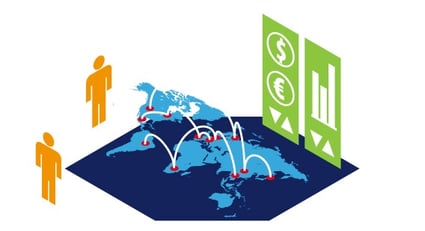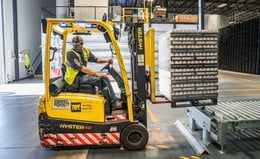4 Benefits of Strategic Network Planning
Brian Hoey - October 16, 2018

 Imagine for a second that you’re entering a friendly betting pool for the 2018 World Cup. Germany won the contest in 2014 (the most recent tournament), so you decide that it stands to reason that Germany will win again this time around. Hindsight being 20-20, we now know that you would have lost your bet, as France won the tournament and Germany didn’t advance out of the first round. Your betting strategy of assuming that past results would continue to hold ultimately wouldn’t prove to be the best approach.
Imagine for a second that you’re entering a friendly betting pool for the 2018 World Cup. Germany won the contest in 2014 (the most recent tournament), so you decide that it stands to reason that Germany will win again this time around. Hindsight being 20-20, we now know that you would have lost your bet, as France won the tournament and Germany didn’t advance out of the first round. Your betting strategy of assuming that past results would continue to hold ultimately wouldn’t prove to be the best approach.
Clearly, assuming that the past will repeat itself endlessly is a poor recipe for sports betting, but it remains a surprisingly common approach in logistics and supply chain management, with shippers and freight forwarders often making plans based on the assumption that past conditions will always hold. If our World Cup wager is any indication, these businesses need to grow out of this mode of thinking if they want to thrive in an ever-changing global value stream. How can a business go about making this change? One method is to adopt a strategic network planning workflow.
1. Planning Certainty Through Data Analysis
Okay, okay. We jumped into the first benefit on somewhat of a cliffhanger: what, exactly, is strategic network planning? Essentially, it refers to the practice in transport logistics of strategically mapping out transport networks (i.e. hubs, warehouses, trucks, routes, yards, containers, delivery points, and everything else that goes into operational transport plans) and adjusting them to align more effectively with specific business goals. This happens through a few different methods, first by creating a digital copy of your existing transport network and then running data analytics on your historical data in order to uncover any areas of waste and predict the outcomes of future changes to your network.
These predictive capabilities, in addition to being the underpinning of this type of workflow, are also the basis of our first tangible benefit. Where, previously, logistics providers have been stuck making uncertain decisions about routing, hub placement, and network administration based on incomplete, past-oriented data, resulting not just in non-optimized logistics but a reluctance to make changes due to the uncertainty of possible outcomes, strategic network planning turns existing data into concrete predictions about the effects of any possible changes or adjustments. This means that planners can develop their plans with confidence as to the likely results, meaning that they will be more willing to take calculated risks and exert the flexibility inherent in their value chains.
2. “What-if” Scenarios
We’ve discussed the ways in which strategic network planning can help logistics providers to map out any potential changes to their network and forecast the effects of those changes, but what if it were also possible to model the effects that changing market and pricing conditions would have on your network? An effective strategic network planning workflow should enable planners to do just that, offering “what-if” simulations and planning sandboxes in which planners can see how their networks hold up under different conditions like, say, dramatic fuel price hikes, the installation of tolls on certain roads, or a sudden uptick in demand. This may sound more like a feature than a benefit, but if we think back to our sports betting analogy, these “what-if” scenarios offer opportunities to simulate individual games with the conditions under which you think they’re likely to occur, meaning that even though you’re relying on advanced analytics software to estimate probable outcomes, you can still set parameters based on your own judgement and expertise. By the same token, you might know from industry experience that a labor shortage is looming (a fact that a predictive algorithm wouldn’t necessarily account for), and could thus run tests on your operations to see how they’ll cope. In this way, businesses avoid a scenario in which they let analytics act as a substitute for human planning knowledge, meaning that they’re less likely to let their use of technology drift away from clearly defined business aims.
3. Increased Opportunities for Collaboration
In the past, making predictions about changes in the administration of a transport network would have potentially been made difficult by information and decision-making silos, meaning that a planner might have been thwarted even just trying to figure the exact routes his or her trucks were tacking between warehouses. Because strategic network planning is by its very nature digital, it has the capacity to break down these silos, creating environments not just of improved data visibility, but of increased collaboration. By working with the same information in a streamlined digital interface, users from disparate points on the value chain (say, warehouse management and truck routing) can easily work together to improve their operations.
4. A More Proactive Value Chain
We spoke a fair amount in the beginning of this post about the importance of unshackling your network planning from past-based assumptions and expectations about demand levels, pricing, and other factors. But is there a larger benefit to breaking away from the patterns of the past and moving into a more future-oriented value chain? Of course! As we alluded to above, by leveraging existing data into stronger predictions and forecasts it’s possible to alleviate the kind of blindered planning workflows that fail because they assume that conditions will continue as is—but let’s take things one step further: if your business is able to model the effects of different conditions and changes in your transport network, all of a sudden it’s possible to transition your planning workflows from reactive (i.e. responding to inevitable disruptions only as they arise) to proactive (i.e. having plan b’s and responses to disruptions and events already in place before they come about). This will bolster the overall flexibility of your logistics processes, ultimately putting you in a position to visualize challenges in advance and meet them head on, retaining maximum value (and even capitalizing on demand changes or price fluctuations) in the face of ever-changing circumstances.
To some extent, this last benefit is the culmination of the effects of the previous three. It represents that gradual transformation in your logistics processes that can take place as you begin to administer your transport network in a more strategic fashion. In this way, logistics providers and transport planners alike can begin to make the move towards a Logistics 4.0 framework, creating smarter, more sophisticated, and better connected value chains in the process.
LATEST POSTS
- Understand Circular Economy in The Manufacturing Industry
- How Can Industry 4.0 IT Integration Be Achieved Smoothly?
- The Significance of Order Sequencing in Discrete Manufacturing
- How to improve your Supply Chain Management: The Power of Control Towers
- Optimizing Human Resource Scheduling in Manufacturing: A Technological Approach



